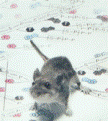Papers in the Biological Sciences

Jay F. Storz Publications
Document Type
Article
Date of this Version
5-2016
Citation
Comp Biochem Physiol A Mol Integr Physiol. 2016 May ; 195: 10–14. doi:10.1016/j.cbpa.2016.01.018.
Abstract
An important means of physiological adaptation to environmental hypoxia is an increased oxygen (O2) affinity of the hemoglobin (Hb) that can help secure high O2 saturation of arterial blood. However, the trade-off associated with a high Hb-O2 affinity is that it can compromise O2 unloading in the systemic capillaries. High-altitude deer mice (Peromyscus maniculatus) have evolved an increased Hb-O2 affinity relative to lowland conspecifics, but it is not known whether they have also evolved compensatory mechanisms to facilitate O2 unloading to respiring tissues. Here we investigate the effects of pH (Bohr effect) and temperature on the O2-affinity of high- and low-altitude deer mouse Hb variants, as these properties can potentially facilitate O2 unloading to metabolizing tissues.
Our experiments revealed that Bohr factors for the high- and low-altitude Hb variants are very similar in spite of the differences in O2-affinity. The Bohr factors of deer mouse Hbs are also comparable to those of other mammalian Hbs. In contrast, the high- and low-altitude variants of deer mouse Hb exhibited similarly low temperature sensitivities that were independent of red blood cell anionic cofactors, suggesting an appreciable endothermic allosteric transition upon oxygenation. In conclusion, high-altitude deer mice have evolved an adaptive increase in Hb-O2 affinity, but this is not associated with compensatory changes in sensitivity to changes in pH or temperature. Instead, it appears that the elevated Hb-O2 affinity in high-altitude deer mice is compensated by an associated increase in the tissue diffusion capacity of O2 (via increased muscle capillarization), which promotes O2 unloading.

